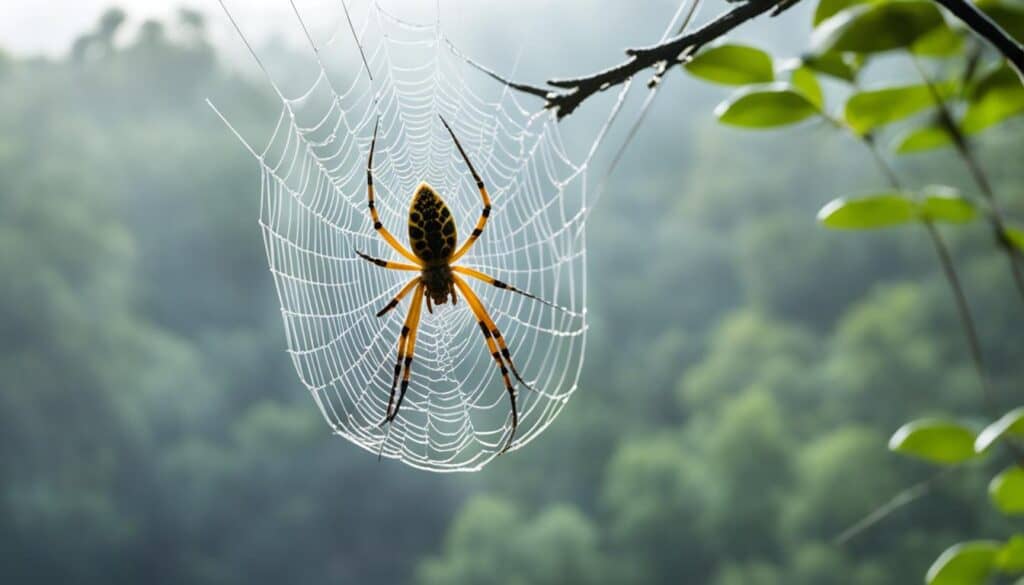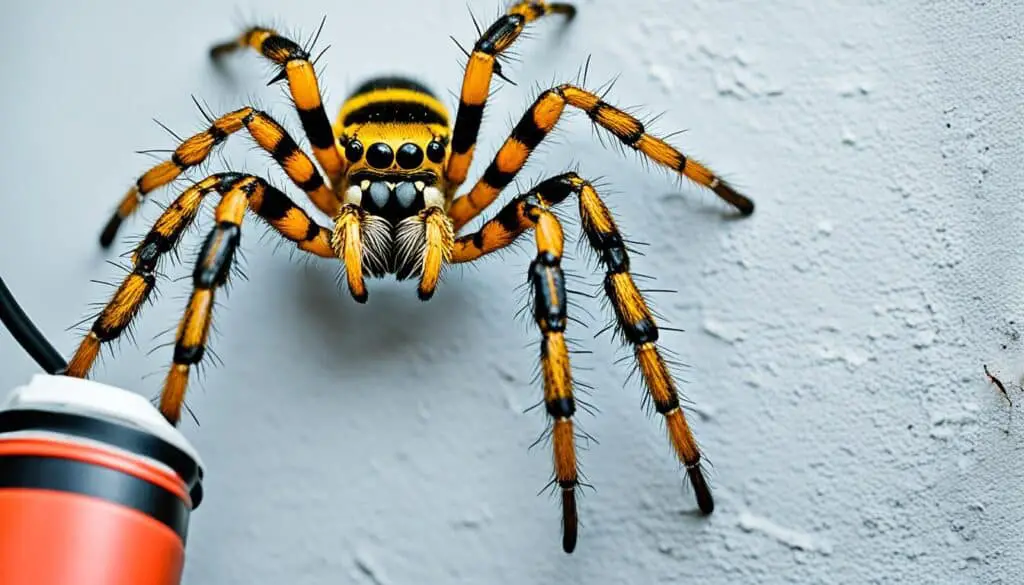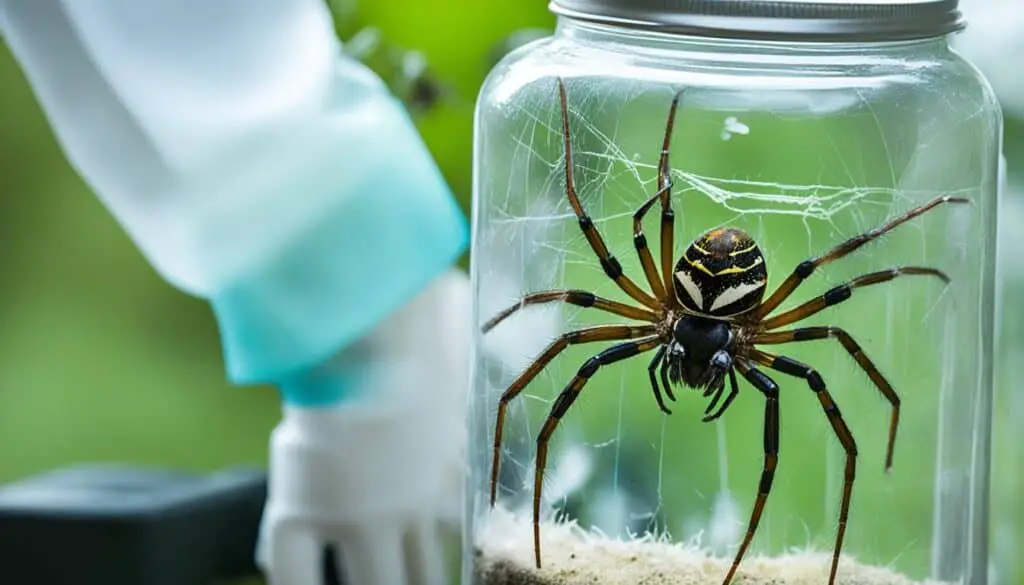Did you know a single female Joro spider can lay up to 1,500 eggs in one year? That’s a ton of spiders! The Joro spider, or Trichonephila clavata, became well-known in the U.S. around 2013 or 2014. They likely got here in container ships from Asia. While they look pretty, these spiders could harm our ecosystems and health.
Joro spiders have spread across northern Georgia and South Carolina in less than ten years. They use a “ballooning technique” to move, which could let them cover up to 100 miles. Without quick action, they’ll continue to spread along the East Coast.
We need to tackle this problem now. With how fast they reproduce and spread, we can’t just hope for the best. It’s important to start control measures immediately. This will protect our native species and our wellbeing.
Key Takeaways
- Female Joro spiders can lay between 400-1,500 eggs in a year.
- Joro spiders likely arrived in the U.S. around 2013 or 2014.
- They have been sighted primarily in northern Georgia and South Carolina.
- Joro spiders are capable of surviving freezing temperatures.
- Rapid and proactive measures are essential to control their spread.

Understanding the Joro Spider: Invasion and Impact
If you’ve been wandering around Georgia lately, you might feel like you’re in a sci-fi movie. This is thanks to the Joro spiders, an Asian species first seen in the U.S. around 2013. Known scientifically as Trichonephila clavata, they quickly became the Southeast’s uninvited guests. These spiders probably arrived on shipping containers and have made themselves right at home since then.
What’s unique about Joro spiders? For one, they have double the metabolism of their relatives and a much higher heart rate. This means they can survive colder temperatures that would kill off their cousins. Because of this, they might spread their webs across the Eastern Seaboard.
Joro spiders have an impressive skill—they can “balloon.” Using their silk like parachutes, they fly on the wind to new places. This is how they’ve spread so fast across Georgia. They can even glide up to 30,000 feet in the air!
Humans have also helped these spiders move around. Whether by car or packing box, Joro spiders are not shy about hitching a ride. Luckily, their fangs can’t pierce human skin, so they’re not a threat to us or our pets. However, they do affect local ecosystems where they live.
In places with lots of Joro spiders, native spiders are disappearing. Their webs can be huge, up to 3 feet, or even 10 feet when combined. These webs can show up anywhere, from forests to gas stations and even your driveway.
When Joro spiders are startled, they might freeze for up to an hour. This is unusual behavior for spiders. Research on how they affect ecosystems is ongoing, but they could be changing native species populations.
Learning how to identify Joro spiders and understanding their behavior is important. They may look pretty, but their effect on our environment is complex.
Identification: Spotting a Joro Spider
Alright folks, let’s dive into how to spot Joro spiders. They have unique looks that make them stand out. Their bodies are colored in bold yellow and blue-black. An adult female’s size and the span of her legs is impressive.
To spot Joro spiders, look at their amazing webs. Their webs are big, golden, and can stretch across large spaces. They’re usually hung up high near trails or trees. This is where Joro spiders like to stay.
The webs give us more hints. During mating season, male Joro spiders can be seen near the webs. A female’s web can be huge, sometimes over 10 feet wide. It’s quite a sight!
Are they dangerous to humans? Not really. Their bite is like a bee sting, not fun but not too bad. Just try to stay away from their webs if you can.
Joro spiders can live up to a year. Seeing one means it could stay around for quite some time. They will keep making their golden webs and showing off their colors.
When you’re outside next time, keep an eye out. Finding a Joro spider will make you the local expert. Plus, you’ll learn to appreciate these fascinating spiders more.


Preventing the Spread of Joro Spiders
Have you ever encountered a spider bigger than an inch? If it’s a Joro spider, it’s no ordinary visitor. These spiders were first seen in 2014 in NE Georgia. Now, they have expanded up to 75 miles by 2022. But don’t worry! There are effective ways to handle these spiders.
Mechanical control is a simple strategy. Remove their webs with a broom to keep them away. A mature female Joro can make webs over 10 feet wide. Clearing these webs stops them from settling in your area.
Another method is nesting prevention. Joro spiders lay eggs in sacs that can hold hundreds of eggs. Find and destroy these egg sacs in the fall to cut down their numbers in spring.
For areas with many spiders, talk to pest control experts. They use powerful treatments like Black Flag Spider and Scorpion Killer. Also, sprays like Zevo Spider and Wasp are very effective. Products with synthetic pyrethroid insecticides are highly recommended too.
Local management is also key. Community reports and professional help can prevent spider infestations. Working with lawn care companies can keep these spiders away. Let’s work together and make our spaces less inviting to Joro spiders. Together, we can keep our yards spider-free. No more unexpected spider visitors!
Control Methods: Effective Techniques for Management
If you’re like me and hate the idea of creepy crawlies making webs around your house, then dealing with the Joro spider is probably high on your list of to-dos. Welcome to the wild world of Joro spider control techniques! We’re talking management strategies sweeter than an apple pie on a summer afternoon.
Let’s be honest: nobody wants to deal with an infestation. The Joro spider, first spotted in NE Georgia in 2014, can lay hundreds of eggs each fall. By 2022, these eight-legged creatures had their webs across a 75-mile radius. So, what’s an arachnophobe to do?
Orkin Pro, anyone? When it comes to professional management, people trust them for good reason. They’re experts on spiders like I’m on my coffee orders (and I know my coffee very well). Hiring professionals can be costly, but for those who are squeamish, it’s a sound choice.
Maybe professional help isn’t your thing. Consider DIY chemical and natural spider repellents then. Trials show products like Black Flag Spider and Scorpion Killer have a 100% success rate against Joro spiders. Zevo Spider and Wasp spray isn’t far behind, with over 97% effectiveness.
Household options are also effective at killing Joro Spiders. Pre-mixed pyrethroids or Green Light Insecticidal Soap have over an 80% kill rate but with a few caveats. You have to be within a foot of the spider and may have to spray it multiple times to kill it. If you’re like me, 1′ away is way too close. Plus, there are no residual effects, so it won’t kill the spider the next time he touches that surface. I’m personally sticking with the stronger stuff.
However, choosing natural methods for prevention is an effective route. Essential oils, like peppermint and tea tree, can ward off spiders and work rather well. A good spray around entry points keeps your home spider-free. It’s like making your place as unappealing to spiders as a gym is to me on weekends.
Mechanical management is a great DIY strategy too. Removing webs and clearing nests helps a lot. Always wear gloves for safety when you do this.
In conclusion, you have many options for getting rid of those uninvited spiders, from Orkin Pro to DIY repellents. Let’s enjoy our homes without the surprise of Joro spiders!
- Zevo Roach Killer Ant, Roach, Spider Insect Spray (10 oz) | Indoor Outdoor Use | Instant Action |…
- Kills on contact
- Kills for up to 16 weeks
- Use indoors or outdoors
- Kills black widow, brown recluse and wolf spiders
- Safe when used as directed
- Extra Concentrated for Long-Lasting Protection
- Natural Ingredients Proven Effective in the Real World
- Large 1 Gallon Container
- Powerful Essential Oil
Regional Focus: The East Coast Dilemma
The East Coast Joro spider problem has everyone buzzing. From Maine to Florida, it’s a big deal. The Joro spider arrived from Asia in 2014, hiding in a shipping container.
This spider has spread fast, adapting like a pro. It’s growing in numbers, just like teenagers with new tech trends.
The Joro spider stands out because it can handle different climate conditions. Other creatures can’t take the heat like it can. With the climate changing, the Joro spider is finding it easier to call the US home.
Farmers have mixed feelings about these spiders. While Joro spiders eat pests like stink bugs, they also create too many webs. Imagine getting your face caught in spider silk while picking apples!
Joro spiders aren’t a major health threat, but they do cause fear. Their bites hurt but won’t send you to the hospital. Still, finding one by your window can be quite scary.
The situation with the East Coast Joro spider is complex. It shows how climate change, economics, and public health intersect. As these spiders spread, they bring both help and new challenges. The East Coast will have to adapt to this webby situation.
Debunking Myths and Sharing Facts
There are many stories about Joro spiders that aren’t true. Let’s sort out the facts from the fiction.
Many believe Joro spiders are harmful to humans. This is incorrect. Despite their bright colors, their bites are not dangerous. At most, you might get an itchy spot or a slight rash.
The Joro spider comes from East Asia. It’s spreading across the South and East Coast of the USA. These spiders are not just pretty; they help control pests by eating insects.
Some think Joro spiders hurt our ecosystem. But, they mainly compete with other spiders for food, not harming the ecosystem much. They eat insects caught in their webs, helping out in gardens.
Spotting a Joro spider is easy. Female spiders are big, with a body length of 1.7-2.5 cm and a leg span of 7-10 cm. Males are half that size. You can see their webs up high, like on powerlines or gas stations. They move around by “ballooning”, which has helped them spread widely.
Now you know the truth about Joro spiders. They’re not scary; they’re interesting and beneficial. Understanding them can reduce our fears and help us appreciate their role in nature.
Conclusion
As we finish our exploration of the Joro spider invasion, it’s evident that being proactive is crucial. These spiders, with their bright colors, are found every two yards in some areas. They were first seen in northern Georgia in 2014 and have spread across over 120,000 square kilometers. This includes states like Georgia, South Carolina, and Maryland.
The Joro spider’s spread is rapid, thanks to natural methods like ballooning and human help. Imagine, one spider every two yards. It’s a big deal compared to stories like Charlotte’s Web. Their growth affects native species, showing the need for more research to protect our ecosystems.
Simple steps can make a big difference in dealing with these spiders. For example, sweeping away webs is a safe and effective way to control them without harming the environment. Since the Joro spider’s native climate matches much of North America, they might keep spreading. We all need to work together to manage this issue well.
In the end, don’t overlook these spiders. Get involved in community efforts and work with researchers. The story of the Joro spider continues, and you can play a key role. Our collective actions and research are vital in lessening their effect on our ecosystems.
Last update on 2025-09-17 at 12:41 / Affiliate links / Images from Amazon Product Advertising API. This page contains affiliate links. As an Amazon Associate, I earn from qualifying purchases.

